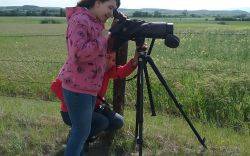The Amazing Long-Billed Curlew
What has a long decurved bill and mottled brown feathers? What is the largest shorebird in North America, and is here in Indian Valley during the summertime? It is the long-billed curlew!
The long-billed curlew is the most graceful and largest shorebird in North America, and the patterns of the feathers give it perfect camouflage from predators. The long-billed curlew is in the Kingdom Animalia, Phylum Chordata, Class Aves, Order Charadriiformes, Family Scolopacidae, and Genus Species Numenius americanus. It is the largest shorebird in North America. The unique bill is long and decurved. The female’s bill is longer than the male and juveniles’ bills. The long-billed curlew has mottled brown feathers with different splashes of dark and light brown color, which helps it hide from predators. The underside of the wings are cinnamon. From head to tail, the length of the long-billed curlew is 23 inches long. Amazingly, the wingspan is 35 inches long. The long-billed curlew weighs 1.3 pounds. The female is larger than the male. The largest shorebird in North America has stripes on its body and wings for perfect camouflage.
The long-billed curlews’ summer habitat is dry grasslands like pastures in Indian Valley. The long-billed curlews breed in dry grasslands and shrub savannahs in North America. A few of them are in Indian Valley in the springtime. The long-billed curlews need ponds and mud for the babies to find bugs to eat. During migration and winter, they can be seen on the mudflats and marshes. Delightfully, the long-billed curlews enjoy frolicking in Indian Valley during the spring.
The long-billed curlews’ behavior is unusual because they are chatty, they display undulating flight, and the end of their bill curls to keep their food from getting away. The birds are loud and noisy when someone drives near their nests. The males scream and are chatty when females are around. The males attract females and defend their territories with undulating flight displays. They flutter and glide like ripples in the wind while calling to the female or trespassers. They gather in small flocks and forage for food by quickly walking with their long bills probing for bugs. The end of the bill curls to keep their food from getting away. Their behavior, though strange, does not hurt people.
The diet of the long-billed curlews includes grasshoppers and other insects, earthworms, berries, crabs and other water creatures. The bills are constructed to find bugs under the ground. The bird uses its bill to break up crabs so that it will be easier to eat. Happily, the long-billed curlews eat large amounts of grasshoppers in Indian Valley. They help people by keeping the bug population under control.
During nesting season, the birds scrape the ground for the nest, the female lays the eggs in the scrape, the male and female both incubate the eggs, and then they take the babies to damper areas as soon as they hatch. The nest is a scrape on the ground that is usually lined with vegetation with a rim around it. They lay four eggs, and if that nest fails, then they only lay three eggs. The eggs are spotted to keep them camouflaged. Both the male and female incubate the eggs for 27-30 days. The male will sit on the eggs while the female finds food for herself. The young leave the nest soon after hatching. They are able to feed themselves, and both parents tend to them and take them to damper areas to find more food. They begin to fly in 32-45 days. The long-billed curlews are good parents.
The long-billed curlews migrate to Mexico and California for the winter and to the Western and Plains States for the summer. They spend the winter in Mexico and California. In mid-March they migrate to the Western States including Idaho, the Rockies and the Plains States. The adults arrive before their nesting grounds dry out. The adults leave their nesting grounds and they fly south by mid-July. The young are left behind with other baby curlews until they are old enough to fly. They fly south in mid-August to meet up with the adults for the winter. Amazingly, the long-billed curlews, including the babies, have strong instincts to know where to migrate.
Concerningly, the long-billed curlew population is declining in southwestern Idaho. They are listed as a species of concern, and a Species of Greatest Conservation Need in Idaho. They are a type of bird that needs conservation and needs our help. The long-billed curlews are in great danger of habitat loss and destruction, human disturbance, and toxic chemicals. There is a conservation team tracking the long-billed curlews with satellite transmitters. They are using the tracking transmitters to answer questions about why the number of long-billed curlews is declining. The conservation team is looking for a flock of birds in Adams County to put transmitters on them next year. The long-billed curlews are in great danger and really need our help. We can help them by keeping track of the flocks, keeping their habitat clean and healthy, advocating for the birds, and giving them plenty of space when we are enjoying them.

Photos courtesy of Heather Hayes. She is the Community Science Coordinator and Research Biologist at the Intermountain Bird Observatory in Boise State University. More information about long-billed curlews can be found at https://ibo.boisestate.edu/.



